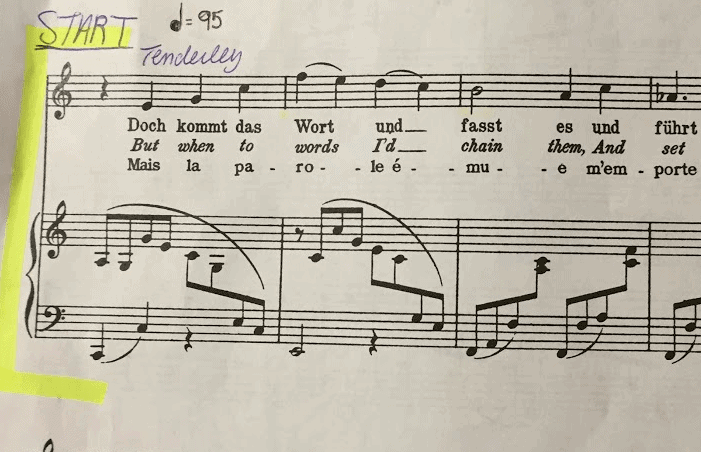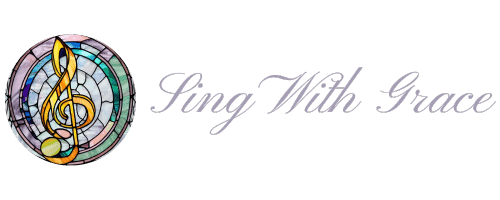You’ve found the perfect song to audition for a musical! If you haven’t, never fear! Just hop on over to my post: 7 steps to picking a standout musical theatre audition song.
Hopefully you already see a couple of sections of the song that would showcase your vocal ability, acting techniques, and personality to help you land that role (if not, stay tuned).
In this post, I share 5 ways to find and mark an audition cut for a musical theatre audition:
- Ensure the song fits the musical style of the show and your vocal range
- Find a section of the song that showcases your voice, acting, and personality
- Decide the specific section of the song that fulfills audition requirements
- Acquire and Clearly Mark Your Sheet Music
- Add Your Slate Before your Song
If you have not yet found that perfect song to illustrate how talented you are to the director, I encourage you to check out the post I mentioned previously.
1. Make Sure Your Song is the Right Style
Does my audition song fit the musical style of the show? Contemporary vs traditional. Rock vs classical. Singing an audition cut with a similar/same style helps the director imagine you performing in the musical you are auditioning for.
Again, I’ve got a post on this here😊
2. Choose a Stellar Audition Cut Section
Listen to the entire song. When choosing a cut, you want to make sure the specific section you choose showcases similar emotions and musical style to those of the character you are auditioning for. For example, a song like “The Wizard and I” contains multiple styles: a more gentle contemporary sound when Elphaba sings “Unlimited…” vs a standout belt at the end “And I’ll stand there with the Wizard….”
If the character you shooting for has a fantastic belty song, you’ll want to choose the belty section of your audition song IF you can sing it! Never choose a section that is not within your range/vocal ability.
Directors want to hear a prepared, clean audition cut. Nobody is perfect and mistakes will happen, but if you choose a section that you can only sing on a really good day, you are setting yourself up for disappointment.
3. Find the Best Section to Fulfill Audition Requirements
You need to make sure that the cut you choose follows the audition requirements as stated on the theatre company’s casting call, website, or wherever else audition information is posted. The preferred audition song style along with the duration of the audition cut are almost always posted, and you do not want to choose a cut a lot longer than what they are asking for because it’s unprofessional and (to some directors) disrespectful.
Directors request a number of bars to indicate the amount of music they want to hear from auditionees, so it is important to choose a section of your song that will closely fit the number of bars (and that you are able to act).
A bar or “measure” is used in music to break up the staff in smaller segments (see the highlighted section of music below).

All you have to do is count how many bars/measures there are in the cut you want to use and make sure it is close to the recommended amount.
Don’t Forget to Think About Tempo!
The amount of time it takes for you to get through a certain amount of lyrics & music will differ depending on the tempo (speed) of the song.
- If you are singing an “upbeat” song you will want to stick to the exact number of bars or add up to 10 bars/measures of music for your cut. For example: if the casting call asks for 32 bars of music, the range I would generally try for is 30-40 bars.
- If you are singing a “ballad” song you will want to keep to the suggested amount of bars or lower for your cut. For example: if the casting call asks for 32 bars of music, the range I would stick to is 25-32.
If the casting call includes a number of bars or a suggested amount of time (ex: up to 1 minute of music), I suggest timing the section of the song you are looking at to see how long it will take. (Some directors will have the stage manager time your audition, so I do not recommend going past the time limit by more than a couple seconds.)
I usually search for a cut at the end of my chosen audition song. Most musical theatre songs have a “big finish” which can be great for showing off your vocal ability and breath support! If you count backward 32 (or whatever the audition cut requirement is) bars starting at the end of a song, you might find a clear starting point like the beginning of a verse.
If an audition cut does not jump out at you, that’s okay. Check out other sections of the song that will showcase your vocal ability and your acting skills (think of the emotions you want to show the director you can portray authentically).
Don’t worry if you can’t find a cut that is exactly 32 bars or 1 minute and 30 seconds long. As long as you showcase your talent and do not go egregiously overboard in the length of your audition cut, you will be great!
4. How to Mark Your Audition Cut
In this section, I will show you some of the common markings for an audition cut on a piece of sheet music. First, you ought to buy/legally acquire your sheet music (print off the internet at your own risk).
Be sure that your audition sheet music has both the piano and vocal part in the music. Usually, an accompanist will not improvise a piano part for you because your music is only chords or a “lead sheet.” Even if they do, it will not be the rhythms/notes you are accustomed to hearing in rehearsal and might throw you off!
Also, make sure that the version of the sheet music you acquire is the same as the song you are practicing. Check the key of the sheet music and the notes themselves. Check if the title of the sheet music is the same as the title of the musical/ artist you think it is by!
For example, the sheet music for “Let’s Hear it for the Boy” from Footloose: The Musical is different than the music for Deniece William’s original song. Try to find a pianist before the audition that can play your audition sheet music so you can hear what your specific accompaniment sheet music sounds like. You can even try Googling the song and “piano accompaniment,” “karaoke,” or “instrumental.” (Again, make sure that these are in the same key as your sheet music!)
If you get nothing else out of this post, I hope you remember this: Make sure you mark everything clearly! You do not want your accompanist frantically searching for where you are starting or ending your song. I suggest marking everything in a medium thickness black or blue pen and highlighting certain things such as key changes in yellow.
These are some must-have markings to help your audition run smoothly:
- START and END marked clearly on the sheet music with beginning and ending brackets. When choosing your starting point, be sure to include the lead-in you want the pianist to play for you so you can hear the key you are singing in and the tempo!
- Tempo and style marking! Usually, you will sing a section of the cut to the pianist to share with him/her what tempo you are taking the song. Adding a marking ensures they will start it at the right tempo/feel.
- Highlight or circle any key changes.
- Highlight any repeats you are taking.
- Note or cross out sections of the song you are skipping.

Remember that in most auditions, you will first walk up to the accompanist to share with them the specifics of your audition cuts. Make sure you share with them ALL of the specifics of your audition cut. The more skips, key changes, and repeats you in your song, the higher the chance the accompanist will make a mistake (understandably!). Keep this in mind when choosing a cut! They are sight-reading this music for you, after all.
Also, make sure you introduce yourself to the accompanist, tell them what you are singing, and say thank you after you are finished!
5. Say Your Slate
Now that you have chosen the best cut to showcase your talent to the director, made sure your version of the sheet music is the correct one and clearly marked it up, you are ready to shine in that audition room!
Part of your singing audition is your “slate” or confidently introducing yourself and the song. This is important so the director knows who you are and what you’re singing (perhaps so they are not wondering the whole time which musical the song you are singing is from).
Here’s my super quick description of how to prepare your slate.
There is quite a bit that goes into the audition itself! If you want to make sure you are remembering everything for your audition, check out my free checklist!
Now you are ready to share your AWESOME audition cut with the directors and get that role! Break a leg!
Grace Brown

Pingback: 3 Steps to Writing the BEST Audition Introductory Slate : Sing With Grace
Pingback: 10 Confidence Boosters for Musical Theatre Auditions : Sing With Grace
Pingback: Complete Musical Theatre Audition Prep Checklist : Sing With Grace